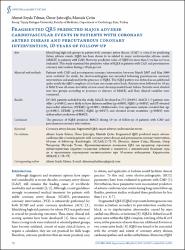| dc.contributor.author | Yılmaz, Ahmet Seyda | |
| dc.contributor.author | Şatıroğlu, Ömer | |
| dc.contributor.author | Çetin, Mustafa | |
| dc.date.accessioned | 2022-10-24T13:42:54Z | |
| dc.date.available | 2022-10-24T13:42:54Z | |
| dc.date.issued | 2022 | en_US |
| dc.identifier.citation | Yılmaz, A. S., Şatıroğlu, Ö., & Çetin, M. (2022). Fragmented QRS predicted major adverse cardiovascular events in patients with coronary artery disease and percutaneous coronary intervention, 10-years of follow-up. Kardiologiia, 62(1), 72–79. https://doi.org/10.18087/cardio.2022.1.n1679 | en_US |
| dc.identifier.issn | 0022-9040 | |
| dc.identifier.uri | https://doi.org/10.18087/cardio.2022.1.n1679 | |
| dc.identifier.uri | https://hdl.handle.net/11436/6833 | |
| dc.description.abstract | Aim Identifying high-risk groups in patient with coronary artery disease (CAD) is critical for predicting future adverse events. fQRS has been shown to be related to major cardiovascular adverse events (MACE) in patients with CAD. However, predictive value of fQRS for more than 5 yrs has not been evaluated. This study examined the predictive value of fQRS in patients with CAD and percutaneous coronary intervention during a 10-yrs period.
Material and methods Patients with CAD and percutaneous coronary intervention between March 2007 and May 2009 were included the study. An electrocardiogram was recorded following percutaneous coronary intervention and analyzed for the presence of fQRS. The fQRS pattern was defined as an additional spike inside the QRS complexes of at least two consecutive leads. Patients were followed for 10 yrs. A MACE was all-cause mortality or new-onset decompensated heart failure. Patients were divided into two groups according to presence or absence of MACE, and their clinical variables were compared.
Results Of 1261 patients included in the study, MACE developed in 374 (29.6%). MACE (+) patients were older (p<0.001), more likely to have diabetes mellitus (p=0.003), fQRS (p<0.001), and ST-elevated myocardial infarction (STEMI) (p<0.001). Multivariable Cox regression analysis revealed that age (p<0.001), STEMI (p=0.001), fQRS (p=0.017), and elevated serum creatinine (p=0.001) were independent predictors of MACE.
Conclusion The presence of fQRS predicted MACE during 10 yrs of follow-up of patients with CAD and percutaneous coronary intervention. | en_US |
| dc.language.iso | eng | en_US |
| dc.publisher | Russian Heart Failure | en_US |
| dc.rights | info:eu-repo/semantics/openAccess | en_US |
| dc.subject | Coronary artery disease | en_US |
| dc.subject | Fragmented QRS | en_US |
| dc.subject | Major adverse cardiovascular events | en_US |
| dc.title | Fragmented QRS predicted major adverse cardiovascular events in patients with coronary artery disease and percutaneous coronary intervention, 10-years of follow-up | en_US |
| dc.type | article | en_US |
| dc.contributor.department | RTEÜ, Tıp Fakültesi, Dahili Tıp Bilimleri Bölümü | en_US |
| dc.contributor.institutionauthor | Yılmaz, Ahmet Seyda | |
| dc.contributor.institutionauthor | Şatıroğlu, Ömer | |
| dc.contributor.institutionauthor | Çet, Mustafa | |
| dc.identifier.doi | 10.18087/cardio.2022.1.n1679 | en_US |
| dc.identifier.volume | 62 | en_US |
| dc.identifier.issue | 1 | en_US |
| dc.identifier.startpage | 72 | en_US |
| dc.identifier.endpage | 79 | en_US |
| dc.relation.journal | Kardiologiya | en_US |
| dc.relation.publicationcategory | Makale - Uluslararası Hakemli Dergi - Kurum Öğretim Elemanı | en_US |


















